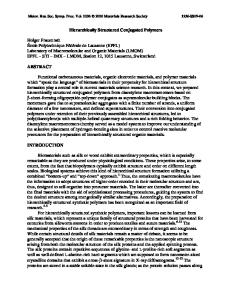Sulfur Containing Conjugated Polymers with Interesting Electronic Properties
- PDF / 289,625 Bytes
- 5 Pages / 414.72 x 648 pts Page_size
- 56 Downloads / 317 Views
1
2
3
THEORETICAL STUDIES Monomers Theoretical calculations first focused on generating geometries and relative energies for the isomeric monomers (C6H 48 4 ) la, lb, 2a, and 3a. For the initial calculations on these 221 Mat. Res. Soc. Symp. Proc. Vol. 328. @1994 Materials Research Society
systems, we employed the method of partial retention of diatomic differential overlap (PRDDO). 2 Subsequently, ab initio MO calculations were performed with GAUSSIAN 923 on both CONVEX C-220 and CRAY Y-MP computers. STO-3G, 4-31G, and 6-31G*4 basis sets were used for the geometry optimization. The effect of electron correlation energy on the relative energies of the monomers was taken into account by performing second-order Moller-Plessent (MP2) 5 perturbation calculations. To obtain the geometries of the oligomers, we first optimized the trimers of all the isomers 1c, 1d, 2b, and 3b (n = 3) at the PRDDO level. Then the central monomer unit
I>=K)s
c>===
S
===< >====(:x:
lb
la
2a
3a
nS lc
ld
S*1 2b
3b
was taken to build up the geometry of the trimer, tetramer, pentamer, and hexamer oligomers. The 4-3 1G6 basis set was used for the energetics of the oligomers since it yielded results closest to those obtained from MP2 calculations on the monomers. These optimized geometries were used for the band structure calculations employing extended Hickel theory 7 since the SCF-Hartree Fock methods greatly overestimates band gaps. The conformations of TTF (la) and tetrathianaphthalene (TTN, 3a) determined by the PRDDO method agrees very well with experiment. 8 ,9 The isomer ld in its extended structure leads to the identical polymer (1) as that derived from the extended form of 1c. Calculated bond lengths were essentially identical to those for TTF. As expected, monomer 3a was found to exhibit two low energy conformations; chair and boat forms. The chair conformation in the monomer is slightly more stable than the boat form. The calculated order of monomer stability is la > 3a > lb >> 2a. Polymers Since the calculations on monomers have no direct bearing on the question of relative stability of polymers, we have performed calculations on the oligomers of 1, 2, and 3. We used la and 1c as reference structures and compared the stabilities between the isomeric oligomers as a function of the same number of repeat units. The results are shown in Table I. The energy differences are the difference between the energy of Ic and the other isomers with the same value of n; AE = Elc - Eisomer. It was found that the stability order for the polymers is different than that for the monomers. In particular, the polymer stability order is 3-chair > 3-boat > 1 >> 2. The stability order regarding the monomers of 1 and 3 reverses on going to the higher oligomers and polymers. These results strongly suggest that the higher oligomers would prefer the hexa-cyclic ring to their penta- or tetra-cyclic isomers.
222
EHT band structure calculations on the three isomeric polymers 1, 2, and 3 were also performed. Band gaps were found to be 2.82, 2.78,
Data Loading...










